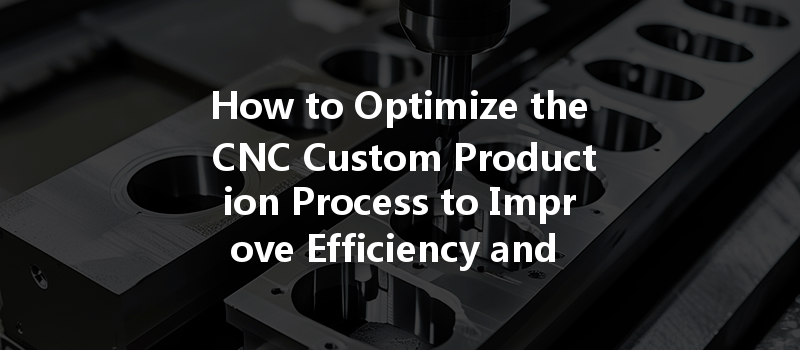Did you know that optimizing CNC (Computer Numerical Control) custom production processes can lead to efficiency improvements by up to 30%? With the continuous advancements in manufacturing technology, many companies are leveraging CNC systems not only for their precision but also for their ability to streamline production. As the manufacturing landscape becomes increasingly competitive, finding ways to optimize production processes is essential for maintaining profitability and meeting customer demands.
In this blog, we will delve into the key strategies for optimizing CNC custom production processes. We will explore various aspects such as workflow design, machining parameters, tool selection, maintenance practices, and data utilization. Our aim is to provide you with a comprehensive guide that will empower your CNC operations for reliability, efficiency, and cost-effectiveness.
Understanding CNC Custom Production
Before we dive into optimization strategies, let’s first understand what CNC custom production entails. CNC machining is a subtractive manufacturing process where pre-programmed computer software dictates the movement of factory tools and machines. This can include lathes, routers, mills, and grinders that create parts from various materials.
Custom production takes it a step further by allowing manufacturers to create unique parts tailored to specific project requirements. This flexibility is what makes CNC machining so appealing in industries ranging from automotive to aerospace and beyond.
Key Benefits of CNC Custom Production
The Need for Optimization
With the advantages of CNC machining evident, it’s important to note that the initial setup for CNC custom production involves significant costs. Therefore, optimizing these processes becomes crucial for reducing lead time and production costs while maintaining high quality.
Strategies for Optimizing CNC Custom Production
An efficient workflow is the backbone of successful CNC operations. Begin by mapping out your production process from start to finish. Identify any bottlenecks or areas of redundancy. Here are some tips for streamlining your workflow:
Your machining parameters greatly affect both the efficiency and quality of CNC parts. Adjusting feed rates, cutting speeds, and depth of cut can yield noticeable improvements. Some strategies include:
Tool selection plays a critical role in the success of CNC operations. Appropriate tooling can significantly reduce machining times and enhance finished product quality.
Preventative maintenance can drastically reduce downtime and costs. Implementing predictive maintenance ensures that machines operate efficiently and are not prone to breakdowns.

Leverage data from your CNC machines to make informed decisions about production processes.
A trained workforce is vital for maintaining high levels of productivity and quality in CNC custom production.
Consider utilizing advanced tool path strategies to enhance efficiency.
Technology Integration in CNC Optimization
As CNC technology evolves, it is essential to stay at the forefront of these advancements to reap the maximum benefits of optimization.
a. Automation and Robotics
Integrating automation and robotics into your CNC operations can enhance efficiency. Automated loaders, for instance, can reduce manual handling time, allowing machines to operate unattended.
b. 3D Printing and Hybrid Technologies
Hybrid manufacturing combines traditional CNC machining with additive manufacturing. This technology is capable of producing complex geometries while reducing waste material.
c. Cloud-Based Production Management
Cloud software solutions for production management provide real-time access to data, allowing for better decision-making and remote monitoring of CNC operations.
In an era where competition is fierce, optimizing CNC custom production processes is no longer optional; it’s a necessity. By emphasizing efficient workflow design, fine-tuning machining parameters, selecting the right tools, implementing predictive maintenance, utilizing data analytics, and investing in employee training, manufacturers can significantly improve production efficiency and reduce costs.
In summary, the optimization of CNC custom processes not only affects the bottom line but also plays a crucial role in sustaining quality and meeting customer expectations. By implementing the strategies discussed in this blog, you can position your CNC operations for long-term success in the dynamic manufacturing landscape.
Remember, this is not just about adopting new technologies but also about fostering a culture of continuous improvement and embracing change. Reflecting on these optimization strategies will not only enhance your current processes but will also pave the way for future innovations.
Are you ready to elevate your CNC custom production process? Your journey to optimization starts now!



